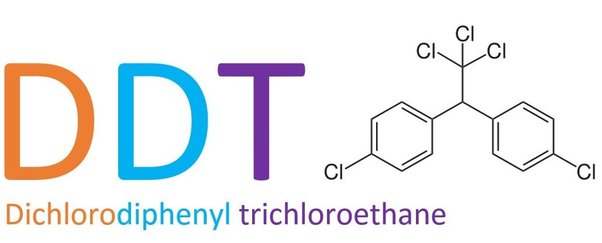
Introduction:
Dichlorodiphenyltrichloroethane, commonly known as DDT, stands as an iconic symbol in the realm of pesticides. Developed in the mid-20th century, DDT played a pivotal role in combating insect-borne diseases and increasing agricultural productivity. However, its widespread use also triggered environmental and health concerns, leading to a complex and controversial legacy. This extensive article aims to unravel the history, chemistry, applications, ecological impact, and regulatory journey of DDT, offering a comprehensive exploration of this influential yet contentious chemical compound.
Chapter 1: The Discovery and Development of DDT
- Discovery by Paul Hermann Müller: DDT was discovered by Swiss chemist Paul Hermann Müller in 1939. Explore the circumstances that led to Müller’s groundbreaking discovery and the subsequent recognition that earned him the Nobel Prize in Physiology or Medicine in 1948.
- World War II and Public Health Significance: DDT’s insecticidal properties gained prominence during World War II when it was used to control insect vectors spreading diseases among troops. Discover how its effectiveness in combating malaria and other insect-borne illnesses led to post-war enthusiasm for its widespread use.
Chapter 2: The Chemistry of DDT
- Chemical Structure and Synthesis: Delve into the chemical structure of DDT, understanding its molecular composition and the synthesis process that transforms raw materials into this organochlorine compound.
- Persistent Nature of DDT: One of the defining characteristics of DDT is its persistence in the environment. Explore the factors contributing to its long-lasting presence in soil, water, and living organisms.
Chapter 3: Applications and Usage Patterns
- Agricultural Applications: DDT’s introduction revolutionized agriculture by effectively controlling crop-damaging pests. Examine the widespread adoption of DDT in farming practices and its role in boosting global food production.
- Public Health Initiatives: Beyond agriculture, DDT found extensive use in public health campaigns to combat malaria and other vector-borne diseases. Analyze the impact of DDT in reducing disease transmission and mortality rates.
Chapter 4: Environmental and Ecological Concerns
- Bioaccumulation and Biomagnification: Investigate the environmental consequences of DDT as it accumulates in the tissues of organisms, leading to biomagnification through the food chain. Understand how this phenomenon raised alarms about potential health risks.
- Impact on Wildlife: Explore the documented cases of DDT’s impact on wildlife, particularly birds of prey like eagles and falcons. The thinning of eggshells and reproductive failures among certain species served as catalysts for environmental awareness.
Chapter 5: Rachel Carson’s Silent Spring
- Pioneering Environmental Awareness: Rachel Carson’s seminal work, “Silent Spring,” published in 1962, became a catalyst for the environmental movement. Investigate how Carson’s exposé on the detrimental effects of DDT and other pesticides ignited public concern and prompted regulatory action.
- Regulatory Response and DDT Bans: Analyze the regulatory response to the concerns raised in “Silent Spring,” leading to the eventual banning or severe restrictions on DDT usage in several countries, including the United States in 1972.
Chapter 6: The Stockholm Convention and Global Perspective
- International Agreements on Persistent Organic Pollutants (POPs): The Stockholm Convention, adopted in 2001, targeted the reduction and elimination of persistent organic pollutants, including DDT. Explore the global effort to mitigate the environmental impact of DDT through international agreements.
- Exemptions for Disease Vector Control: Despite the bans, certain exemptions were made for the continued use of DDT in disease vector control. Examine the delicate balance between environmental protection and public health priorities in these exceptions.
Chapter 7: DDT in the 21st Century
- Resurgence in Malaria Control: Investigate the limited and controlled use of DDT in the 21st century, particularly in regions grappling with high malaria burdens. Assess the ongoing debate surrounding the effectiveness and ethical considerations of DDT in malaria control.
- Scientific Research and Monitoring: Delve into contemporary scientific research focused on monitoring DDT residues, understanding its persistence, and evaluating the potential risks associated with its current usage.
Chapter 8: Lessons Learned and Future Perspectives
- Balancing Act: Reflect on the lessons learned from the DDT saga, emphasizing the delicate balance required when addressing public health needs, agricultural demands, and environmental conservation.
- Alternatives and Sustainable Practices: Explore the development and adoption of alternative pest control methods and sustainable agricultural practices that aim to minimize the environmental impact while addressing the challenges DDT once sought to overcome.
Conclusion:
In conclusion, the legacy of DDT is a tale of both triumph and tribulation. From its groundbreaking role in public health and agriculture to the environmental concerns that led to its restrictions, DDT remains a powerful symbol in the ongoing discourse on the delicate interplay between technological innovation, human health, and ecological well-being.
As society continues to grapple with the consequences of past decisions, the story of DDT serves as a cautionary narrative, urging us to approach novel technologies with a holistic understanding of their potential impacts. The ongoing debates surrounding DDT highlight the complexities inherent in managing global challenges, emphasizing the need for nuanced and sustainable solutions to navigate the intricate web of human and environmental health.